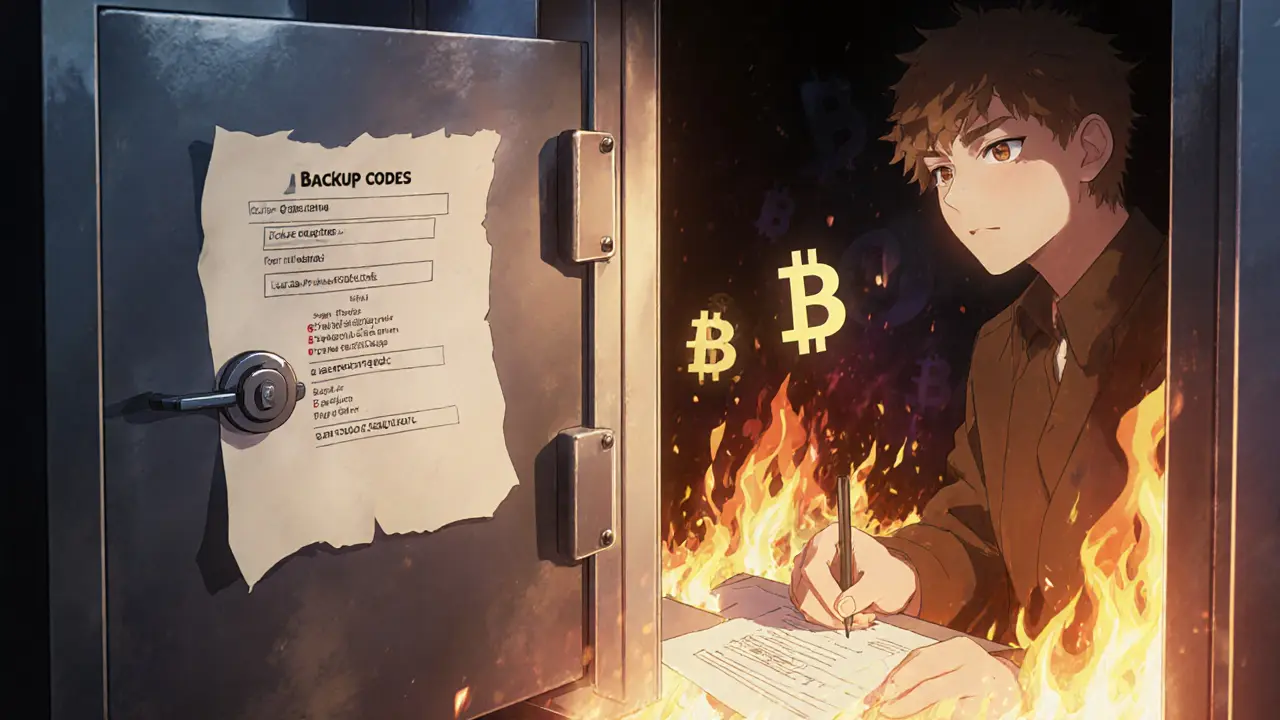Imagine this: you wake up to a notification that all your Bitcoin is gone. Not because the market crashed. Not because you made a bad trade. But because someone guessed your password and walked right into your account. No alarm. No warning. Just gone. That’s what happens when you skip 2FA for cryptocurrency accounts.
Crypto isn’t like your bank. If someone steals your cash from a checking account, the bank can reverse it. With crypto? Once it’s sent, it’s gone forever. That’s why 2FA isn’t just a nice-to-have - it’s the bare minimum you need to keep your assets safe.
How 2FA Actually Works for Crypto
Two-Factor Authentication (2FA) means you need two things to log in: something you know (your password) and something you have (a code from your phone or a key fob). It’s simple, but powerful.
Here’s how it works in practice. You enter your password on Binance, Kraken, or your MetaMask wallet. Then, instead of being let in right away, you’re asked for a six-digit number. That number isn’t sent via email or SMS - it’s generated by an app on your phone, like Google Authenticator or Authy. The app and the exchange both know the same secret key. Every 30 seconds, they generate a new code based on that key and the current time. If the codes match, you’re in.
Some platforms also let you use a physical security key - like a YubiKey - that you plug into your computer or tap with NFC. That’s even better. No app needed. No phone required. Just a tiny device that only you can touch.
Why SMS 2FA Is a Bad Idea for Crypto
You might think, “I just use SMS codes - that’s good enough.” It’s not.
SMS-based 2FA is vulnerable to SIM-swapping. A hacker calls your mobile provider, pretends to be you, and convinces them to transfer your phone number to a new SIM card they control. Suddenly, all your text messages - including your 2FA codes - go to them, not you.
There are real cases of people losing six-figure crypto holdings this way. In 2023, a UK investor lost £180,000 in Ethereum after a SIM-swap attack. His phone number was hijacked. His 2FA codes were stolen. His account emptied in minutes.
App-based 2FA doesn’t rely on your phone number. It runs locally on your device. Even if your phone is stolen, the attacker still needs your password and your unlock PIN to open the app. That’s two barriers, not one.
Setting Up 2FA: Step-by-Step
Most exchanges walk you through this, but here’s what you actually need to do - and what most people mess up.
- Download an authenticator app - Google Authenticator or Authy. Avoid random apps from the app store. Stick to trusted names.
- Log into your crypto exchange and go to Security Settings.
- Turn on 2FA. You’ll see a QR code.
- Open your authenticator app and scan the QR code.
- Enter the code the app generates into the exchange to confirm.
- Save your backup codes. Seriously. Write them on paper. Store them in a fireproof safe. Don’t screenshot them. Don’t email them. Don’t put them in Notes.
That last step is critical. If you lose your phone, wipe it by accident, or it breaks - your backup codes are your only way back in. Lose them, and your crypto is locked forever. No customer support can help you if you don’t have the recovery keys.

What Happens When You Lose Your 2FA Device?
People panic when their phone dies or gets stolen. They think, “I’m locked out forever.” You’re not - if you did it right.
Most platforms have a recovery process. You’ll need to:
- Provide your backup codes
- Verify your identity with government ID
- Wait 24-72 hours for manual review
Some platforms, like Crypto.com’s NFT section, lock withdrawals for 24 hours after you enable 2FA. That’s intentional. It stops hackers from immediately draining your assets after they take over.
But here’s the catch: if you didn’t save your backup codes? You’re stuck. No recovery. No exceptions. That’s why writing them down isn’t optional - it’s survival.
Hardware Keys: The Gold Standard
If you’re holding more than a few thousand dollars in crypto, skip the app. Get a hardware key.
YubiKey, Titan Security Key, or other FIDO2-compatible devices are plug-and-play. You plug it into your USB port, tap it, and you’re logged in. No codes. No phone. No app to hack.
These keys are immune to phishing. Even if you accidentally type your password into a fake website, the key won’t respond unless it’s on the real site. No other 2FA method can say that.
They’re not cheap - around $50-70 - but compared to losing $10,000 in Bitcoin? It’s a bargain. Many serious crypto users use both: an authenticator app as a backup, and a hardware key as the primary method.

2FA Isn’t Enough - Here’s What Else You Need
2FA stops 90% of attacks. But not all. If someone installs spyware on your phone, they can steal your codes. If you reuse passwords, they can guess them. If you click a fake link, they can take over your email and reset your 2FA.
So what’s the full picture?
- Use a hardware wallet (like Ledger or Trezor) to store large amounts offline
- Never reuse passwords - use a password manager
- Enable login alerts on your exchange
- Turn off SMS login options if your exchange allows it
- Regularly check connected devices in your security settings
Think of 2FA as a lock on your front door. Great. But if your windows are open, or your spare key is under the mat, you’re still in danger.
Real Stories: What Happens Without 2FA
In 2024, a Reddit user in Toronto lost $250,000 in ETH because he didn’t use 2FA. He got a phishing email that looked like his exchange’s login page. He entered his password. The hacker logged in - and drained the account in 47 seconds.
Another user in Berlin had 2FA enabled - but used SMS. A hacker social-engineered his mobile carrier and took over his number. The hacker reset his password, got the 2FA code via SMS, and emptied his wallet. He lost $1.2 million.
These aren’t rare. They happen every week. And they’re always preventable.
Final Rule: 2FA Is Your Lifeline
Crypto is built on trustless technology - but your security isn’t. You’re the only one responsible for your keys. No bank will refund you. No government will step in. No algorithm will undo a transaction.
2FA is the simplest, cheapest, most effective way to protect your crypto. It takes five minutes to set up. It costs nothing. And it can save you millions.
Don’t wait for a breach to happen. Do it today. Scan the QR code. Write down the backup codes. Put them somewhere safe. Then sleep better tonight.
Is 2FA mandatory for crypto exchanges?
Many major exchanges like Binance, Coinbase, and Kraken require 2FA for withdrawals and high-value transactions. Some platforms, like Crypto.com’s NFT marketplace, make it mandatory for any account activity. While not every exchange forces it for login, skipping it is like leaving your front door unlocked - you’re asking for trouble.
Can I use 2FA without a smartphone?
Yes. You can use a hardware security key like YubiKey that works with USB, NFC, or Bluetooth. These don’t need a phone or internet connection. You just plug it in or tap it to log in. Some users even keep a backup key in a safe deposit box for emergencies.
What’s the difference between Google Authenticator and Authy?
Google Authenticator is simple and secure - but if you lose your phone, you lose your codes. Authy adds cloud backup (encrypted) and lets you sync across devices. That’s useful if you switch phones often. Both are better than SMS, but Authy’s backup feature makes recovery easier if you’re not perfect at saving codes.
Do I need 2FA for my crypto wallet too?
If you’re using a custodial wallet (like Coinbase Wallet or MetaMask with cloud sync), yes - enable 2FA there too. If you’re using a non-custodial wallet like Ledger or Trezor, 2FA isn’t needed for the wallet itself, because your private keys never leave the device. But you still need 2FA on any exchange or service you connect to.
Can hackers bypass 2FA with malware?
Yes, but only if they’re already on your device. Keyloggers or screen capture malware can steal your password and 2FA code if you enter them on an infected computer. That’s why you should only log into crypto accounts on trusted devices, avoid clicking suspicious links, and use hardware keys when possible - they’re immune to most malware.
What should I do if I lose my 2FA backup codes?
Contact your exchange’s support team immediately. They’ll ask for ID verification and proof of ownership. The process can take days, and there’s no guarantee of recovery. This is why storing backup codes offline - on paper, in a safe - is the most important step you’ll ever take for crypto security.


Post Comments (1)
Just set up my YubiKey last week and I feel like a crypto ninja now. No more worrying about SMS hijacks - this thing is a tank. Seriously, if you're holding more than a few grand, get one. It's the only 2FA that makes me sleep without checking my phone every 10 minutes. 😎